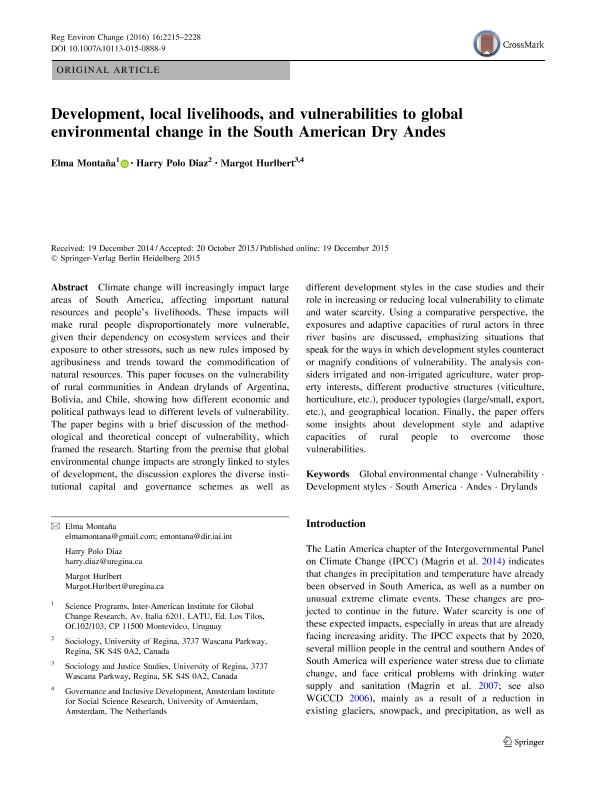Mostrar el registro sencillo del ítem
dc.contributor.author
Montaña, Elma Carmen

dc.contributor.author
Diaz, Harry Polo

dc.contributor.author
Hurlbert, Margot

dc.date.available
2017-05-12T19:50:00Z
dc.date.issued
2015-12
dc.identifier.citation
Montaña, Elma Carmen; Diaz, Harry Polo; Hurlbert, Margot; Development, local livelihoods, and vulnerabilities to global environmental change in the South American Dry Andes; Springer Heidelberg; Regional Environmental Change; 16; 8; 12-2015; 2215-2228
dc.identifier.issn
1436-3798
dc.identifier.uri
http://hdl.handle.net/11336/16412
dc.description.abstract
Climate change will increasingly impact large areas of South America, affecting important natural resources and people?s livelihoods. These impacts will make rural people disproportionately more vulnerable, given their dependency on ecosystem services and their exposure to other stressors, such as new rules imposed by agribusiness and trends toward the commodification of natural resources. This paper focuses on the vulnerability of rural communities in Andean drylands of Argentina, Bolivia, and Chile, showing how different economic and political pathways lead to different levels of vulnerability. The paper begins with a brief discussion of the methodological and theoretical concept of vulnerability, which framed the research. Starting from the premise that global environmental change impacts are strongly linked to styles of development, the discussion explores the diverse institutional capital and governance schemes as well as different development styles in the case studies and their role in increasing or reducing local vulnerability to climate and water scarcity. Using a comparative perspective, the exposures and adaptive capacities of rural actors in three river basins are discussed, emphasizing situations that speak for the ways in which development styles counteract or magnify conditions of vulnerability. The analysis considers irrigated and non-irrigated agriculture, water property interests, different productive structures (viticulture, horticulture, etc.), producer typologies (large/small, export, etc.), and geographical location. Finally, the paper offers some insights about development style and adaptive capacities of rural people to overcome those vulnerabilities.
dc.format
application/pdf
dc.language.iso
eng
dc.publisher
Springer Heidelberg

dc.rights
info:eu-repo/semantics/openAccess
dc.rights.uri
https://creativecommons.org/licenses/by-nc-sa/2.5/ar/
dc.subject
Global Environmental Chamge
dc.subject
Vulnerability
dc.subject
Development Styles
dc.subject
South American Andes
dc.subject.classification
Ciencias Sociales Interdisciplinarias

dc.subject.classification
Otras Ciencias Sociales

dc.subject.classification
CIENCIAS SOCIALES

dc.title
Development, local livelihoods, and vulnerabilities to global environmental change in the South American Dry Andes
dc.type
info:eu-repo/semantics/article
dc.type
info:ar-repo/semantics/artículo
dc.type
info:eu-repo/semantics/publishedVersion
dc.date.updated
2017-05-09T18:03:24Z
dc.identifier.eissn
1436-378X
dc.journal.volume
16
dc.journal.number
8
dc.journal.pagination
2215-2228
dc.journal.pais
Alemania

dc.journal.ciudad
Heidelberg
dc.description.fil
Fil: Montaña, Elma Carmen. Consejo Nacional de Investigaciones Científicas y Técnicas; Argentina. Inter-American Institute for Global Change Research; Uruguay
dc.description.fil
Fil: Diaz, Harry Polo. University of Regina; Canadá
dc.description.fil
Fil: Hurlbert, Margot. University of Regina; Canadá. University of Amsterdam; Países Bajos
dc.journal.title
Regional Environmental Change

dc.relation.alternativeid
info:eu-repo/semantics/altIdentifier/doi/http://dx.doi.org/10.1007/s10113-015-0888-9
dc.relation.alternativeid
info:eu-repo/semantics/altIdentifier/url/https://link.springer.com/article/10.1007%2Fs10113-015-0888-9
Archivos asociados
